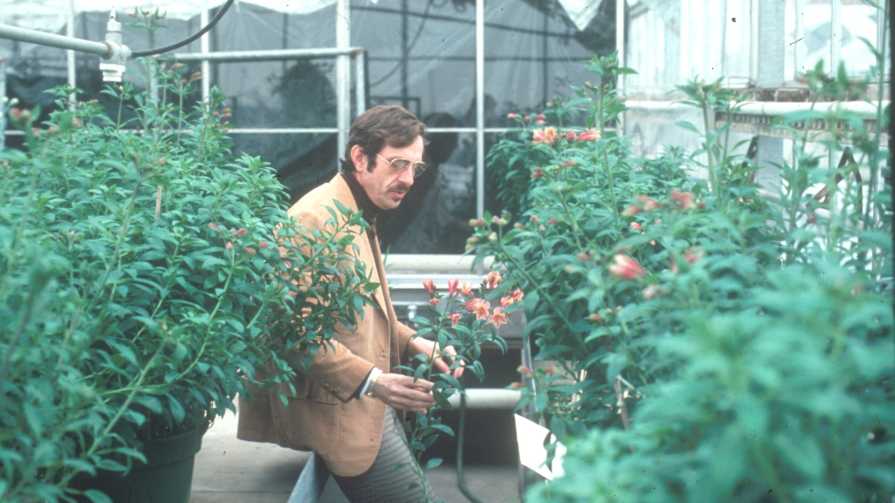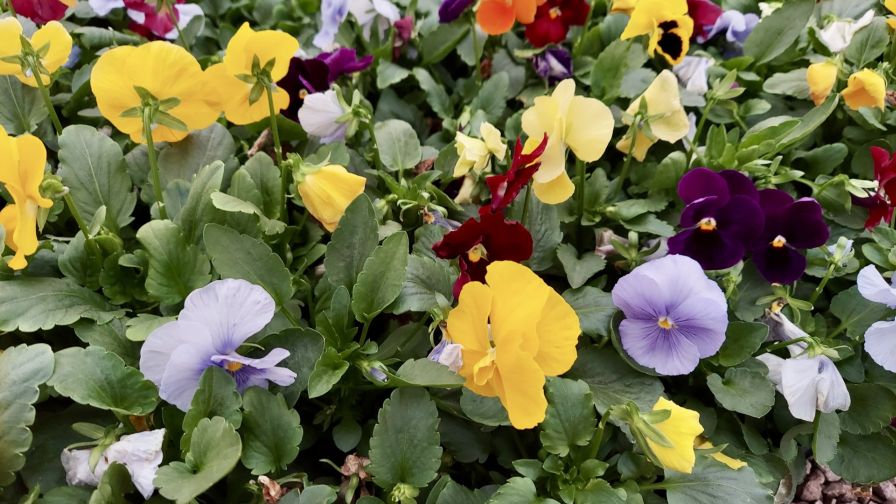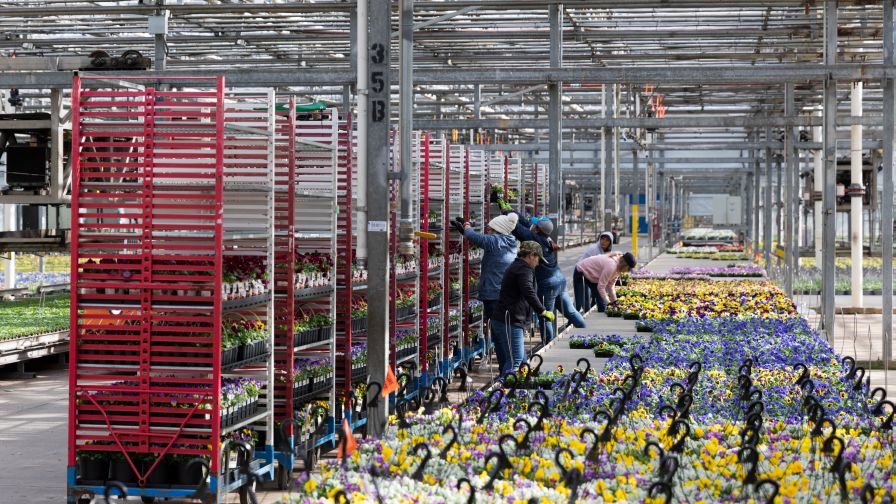Floriculture Industry Mourns Passing of Harold Wilkins

Harold Wilkins, 1982
Editor’s Note: Much of the information below comes from Mary Maguire Lerman, Emily Dusek, Marvin Miller, and John Dole, who prepared a tribute to Dr. Harold Wikins for the American Society for Horticultural Science’s HortScience Journal that will be published in the near future.
Dr. Harold F. Wilkins, Professor Emeritus, Department of Horticulture, University of Minnesota, passed away on Thursday, Jan. 7, 2021. Wilkins was a major force in the floriculture world, creating ideas, generating research, and mentoring students that profoundly influenced industry and academic directions.
A lover of flowers for all his life, Harold was born Nov. 3, 1933, in Cobden, IL. A 1951 graduate of Anna Jonesboro High School, he advanced to the University of Illinois at Urbana-Champaign where he earned his B.S., M.S., and Ph.D. During two years of his Ph.D. program, he also attended Cornell University in Ithaca, NY. Following completion of his Ph.D., he spent an additional two years of study in postharvest physiology at the University of Florida Gulf Coast Research Center, Bradenton. From 1966 to 1989, he taught and served as the Extension floriculture professor at the University of Minnesota’s Saint Paul campus.
Harold’s impact on the floriculture industry and research cannot be overstated. His career spanned a time of major change in the floriculture industry, which was growing rapidly and in great need of formal, tested information. In close cooperation with the industry, Harold and his colleagues around the world developed the production and forcing protocols that allowed many crops to become reliable, predictable and, most importantly, profitable. Harold had a creative and inquisitive mind that looked at research problems from different perspectives than most. Additionally, he was unafraid to try new ideas, or as was commonly the case, have his graduate students try them. Many experiments did not work out as intended. But more often than not, they did, yielding intellectual leaps forward.
His research over the years included many floral crops, with a particular focus on cool weather crops that would require less energy for production, reducing the cost of operating greenhouses in the cold Minnesota climate. These crops included Easter lilies, freesias, azaleas, and alstroemeria. Dr. Wilkins’ research helped create the multi-million-dollar alstroemeria industry here in the U.S., and he is considered the Father of the alstroemeria industry worldwide. His freesia research created the year-round flowering programs using soil temperature management. His love of cut flowers and floral design led him to propose and host a symposium on Commercial Field Production of Cut and Dried Flowers in 1988, which would fuel the specialty cut flower industry and help lead to the creation of the Association of Specialty Cut Flower Growers by Allan Armitage and Judy Laushman in 1989. Other major areas of research included branching control for roses, carnations and poinsettias, and much more.
 Harold was ever humble and attributed much of his success over the years to his graduate students: Bert Swanson, W.C. Lin, Mark Roh, Marsha Celeste, Royal Heins, Terry Gilbertson-Ferris, Will Healy, Brent Pemberton, Kevin Grueber, Nancy Olson, Peter Bierman, Charlene Baker, Carole Zakkour, John Dole, and Michael Evans (in order of graduation), always putting their names before his own on research publications. Harold was proud that his students went on to lead floriculture education and research at major universities and businesses in the U.S. and Canada. Hundreds of his undergraduate students continue to amaze their employers and families with their floral knowledge. Beloved by his students, he considers many to be his sons and daughters and regards their children, both personal and academic, as his grandchildren.
Harold was ever humble and attributed much of his success over the years to his graduate students: Bert Swanson, W.C. Lin, Mark Roh, Marsha Celeste, Royal Heins, Terry Gilbertson-Ferris, Will Healy, Brent Pemberton, Kevin Grueber, Nancy Olson, Peter Bierman, Charlene Baker, Carole Zakkour, John Dole, and Michael Evans (in order of graduation), always putting their names before his own on research publications. Harold was proud that his students went on to lead floriculture education and research at major universities and businesses in the U.S. and Canada. Hundreds of his undergraduate students continue to amaze their employers and families with their floral knowledge. Beloved by his students, he considers many to be his sons and daughters and regards their children, both personal and academic, as his grandchildren.
Harold had a major impact on floriculture through his writing and his advocacy. He co-authored two editions of Floriculture Species and Production, now the standard text at universities worldwide and a major industry reference. He wrote hundreds of scientific articles, trade journal articles, and book chapters, and he gave an untold number of presentations, both domestically and internationally. An avid traveler, he developed an international perspective, taking ideas abroad and bringing different innovative ideas back to Minnesota. He loved meeting international floriculture researchers, visiting their labs, exploring their industries, and fostering a global perspective.
He valued floriculture and was dedicated to serving its people. Many days he stayed late at the office returning growers’ phone calls, delivering soil and tissue testing results, and working on the Minnesota Commercial Flower Growers Bulletin. He felt strongly that floriculture needed more financial support. He served as the catalyst for the Floriculture and Nursery Crops Research Initiative (FNRI) by bringing together the ideas, people and organizations to get it off the ground. He was an ongoing supporter of the American Floral Endowment and its programs.
In November 2005, Harold and his partner Bryan Gjevre began a new “retirement” venture. They purchased a 9-acre farm near Baldwin, WI, and were so sure of the sale that they planted 24 tulips on the land before closing the deal. Since 2006, they have planted unusual woody and herbaceous ornamentals to sell to unique floral shops in the Twin Cities and western Wisconsin. In addition, Harold and Bryan provided exceptional cut flowers, bouquets, and designs for clients who peruse the Mill City Farmers Market on Saturdays in downtown Minneapolis. The “Wilkins’ Bow” was hand-crafted by Harold for many bouquets while his customers watched the complicated procedure.
Over the years Harold has received numerous floriculture industry awards, for which he was most proud. The Society of American Florists (SAF) inducted him into their Floriculture Hall of Fame in 1988 for his outstanding research and graduate student training efforts (SAF has established a memorial tribute in memory of Wilkins). SAF also recognized him with the Alex Laurie Award for outstanding research and education. Other industry awards include the American Horticultural Society Award of Excellence; The Ohio Florists’ Association’s Best Paper, 1985; Minnesota Commercial Flower Growers Association, Special Award of Appreciation; and Minnesota State Horticultural Society, Bronze Award.
Harold was inducted as a Fellow of the American Society for Horticultural Science in 1984. Harold was especially honored to receive the Outstanding Floriculture Research Paper, along with his students, in 1967, 1978, 1980, 1985, and 1992. Pi Alpha Xi, the honorary horticulture society, inducted him as a Fellow in 1992 and he was a member of the University of Minnesota President’s Club. Harold was a proud member of Pi Alpha Xi, Gamma Sigma Delta Honorary, and Phi Sigma Biological Society and a Guardian of the American Floral Endowment.
Harold Wilkins had a major impact on the floriculture industry and academics. With his larger-than-life personality and tireless energy, he leaves behind Bryan Gjevre and many students and colleagues. His memory will be kept alive through their stories of his generosity, devotion, and service and occasionally, stories of mischief, mayhem, and mishaps.
A Note From Dr. Allan Armitage About Harold Wilkins
“We evolve. As people, our lives evolve in small steps. If we are lucky, we have help negotiating those steps. If we are really lucky, we have someone like Dr. Harold Wilkins. To see Harold at any gathering was to see the sun shine, to hang out with Harold was to understand the meaning of respect and kindness. Harold touched a lot of people, and every one of us is the better for it. I have had wonderful mentors help me find my way, but having Harold light my path is a gift I appreciate every day.”
Please feel free to post any of your own reflections on Wilkins’ legacy in the Comments box below.










